Hugelkultur is a method of making a garden bed using waste wood and available nitrogen, that preserves those nutrients and gives them up to growing plants over several seasons. Like compost, a hugelkultur bed or hugel bed makes use of carbon and nitrogen to decompose and create humus, while generating both heat and moisture.
Hugelkultur beds:
- Heat up faster in the spring
- Retain moisture
- Need no additional fertilizer
- Need less irrigation
- Produce more food in less space
- Are an efficient use of resources
- Are easier to weed
- Are great for perennial crops
- Are rich in nitrogen
- May need supplemental minerals or kelp fertilizer to balance
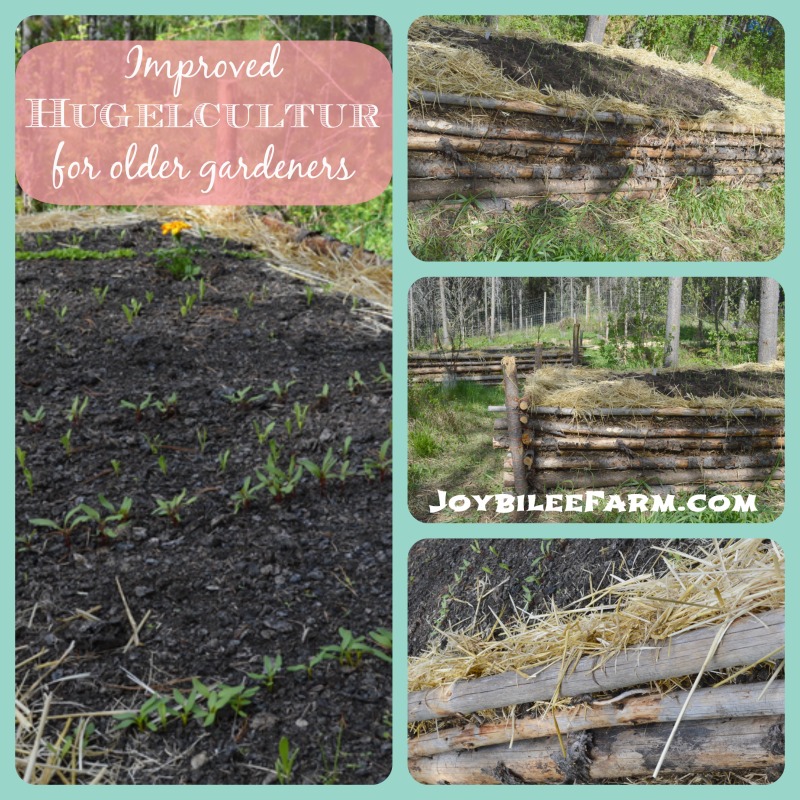
Two years ago we built a hugelkultur bed in our forest garden using waste wood, straw, animal manure, and finished compost. The bed had some difficulties.
Year one:
I planted carrots and beets in the hugel bed the first year. The root vegetables air-pruned when the long roots went through the compost on the top of the bed and hit the area below where the waste wood was. That meant, that while the carrots did grow, we didn’t get much of a harvest. But it was a good learning experience.
Year two:
My chickens got through the fence in the second year and scratched out quite a bit of the surface compost from the top of the bed. We replenished the finished compost and built the bed back up the second spring, and planted strawberries. The bed was easy to weed. The strawberries did well. Near the end of the season the strawberry leaves turned pale with pronounced green veins – chlorosis. This is corrected with the addition of a magnesium solution, which increases the bioavailability of some trace minerals in the soil.
Year 3:
The hugel bed shrunk in height in the third year, as more of the waste wood rotted beneath. The bed was quicker to heat up in the spring and retained its moisture, not needing to be watered when the rest of the garden was. The leaves are again showing signs of chlorosis and will need to be treated with magnesium sulphate to increase the bioavailablity of trace minerals.
What I wanted changed:
Over all, I wanted the hugel bed to be higher so that, as I get older, I can garden with less bending and squatting. The hugel bed can be made as high as the available waste wood. Our farm helper built two new hugel beds this year and built up the walls with logs so that the beds are high enough that I can garden standing up. I love it. They were so easy to plant and will be easy to weed as well. The beds were finished two weeks ago and after the first rain, they started to warm up significantly. Both are already planted. Seed germination was quick and thorough.
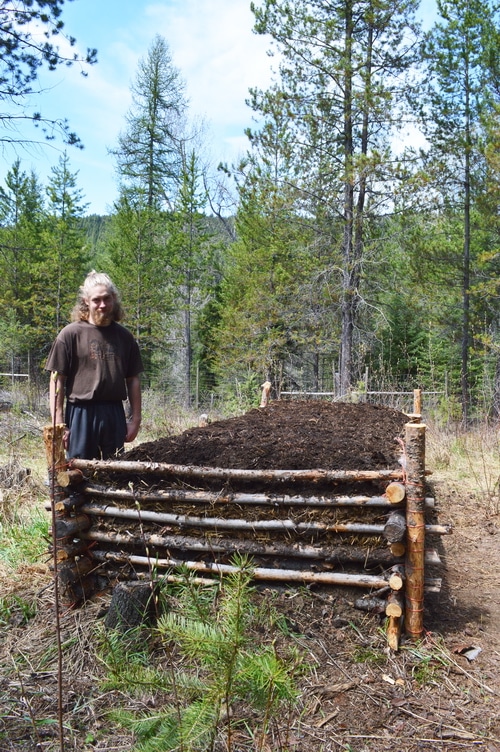
Nathan, our farm helper, built the sides up with waste wood, and threw the stumps and branches in the middle of the bed, to provide the foundation.
Since we raise llamas there were several llama dung piles around the barn yard, and Nathan cleaned those up and dumped the dung over the logs to fill up the spaces. Two jobs with one action – economy of time. This was topped with about a foot of 1 year old composted manure – still clumpy with lots of hay and straw in it. The final layer was a foot of finished compost ready to plant. I pushed straw around the perimeter of the top of the bed to catch any irrigation run off and keep it in the bed. Once the seeds are 6 inches high, and it warms up here, I’ll mulch the bed with straw to prevent the surface from drying out.
What I like about the new design:
- It’s taller
- It is neater in appearance
- The sides won’t cave in as the bed decomposes
- I can garden standing up
- It’s deeper and therefore has more mass to retain heat and moisture
- It’s less fatiguing to plant standing up than to plant bending over
- The plants in the hugel bed are growing more quickly than the plants I put in the ground at the same time.
- Soil moisture can be made more efficient by digging a trench around the bed to catch run-off and direct it back to the bed.
- The raised bed is easier to cover with row covers to extend the season.
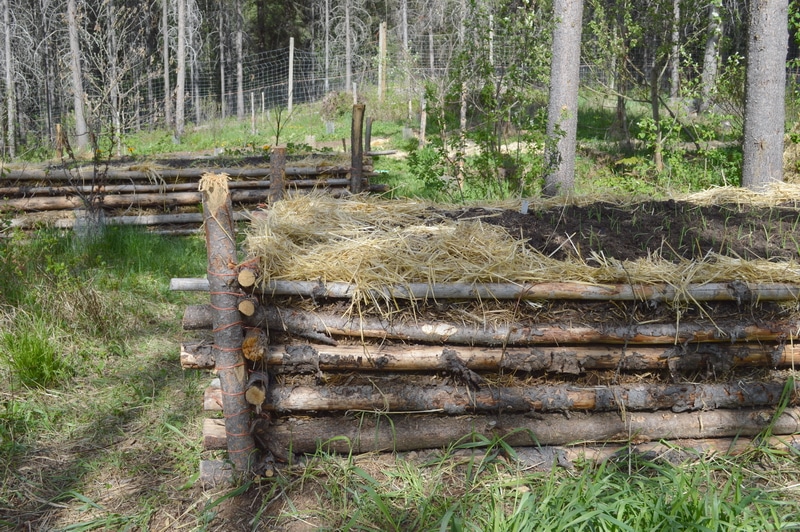
Some drawbacks:
I noticed that some of the waste wood had ants and I will have to discourage them from using the hugel bed as a home
There are places for mice, voles, and wasps to house within the walls of the hugel bed, so I’ll need to watch for this, and take steps to discourage it.
The bed will sink as the waste wood decomposes and more compost will have to be added periodically. This is not really a draw back as I have lots of manure and composted manure on the farm and this makes good use of it.
I’ll avoid growing plants with long tap roots, like carrots, beets, and kale until the bed has been established for several seasons.
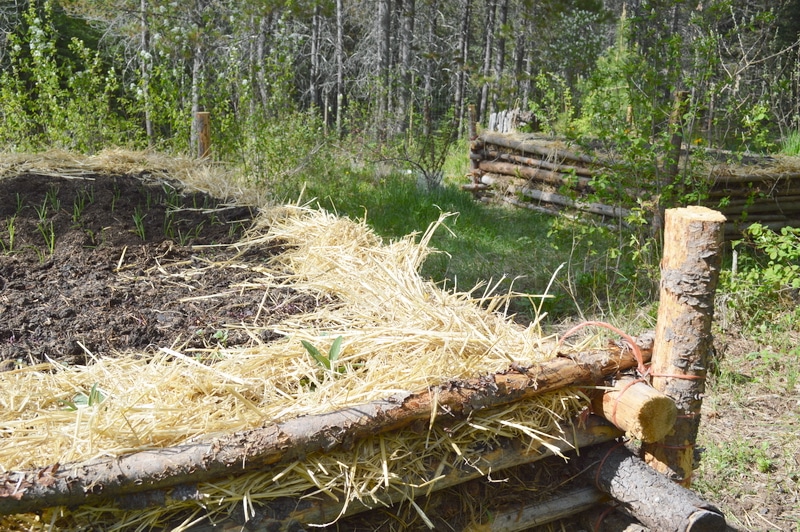

The hugel bed is a permaculture technique to increase the efficiency of biowaste products and grow more food. I think it’s a really good technology. There are as many forms of hugelkultur as there are gardeners. I suggest that you take the good points that work for you, and as I did, fine tune them to your own situation and the available biomass that you have to work with.
As the bed decomposes and shrinks, you’ll want to add more compost to the surface to keep it high. Larger hugelbeds made with the help of a tractor and utilizing whole trees, won’t need as much attention as smaller, human size beds.
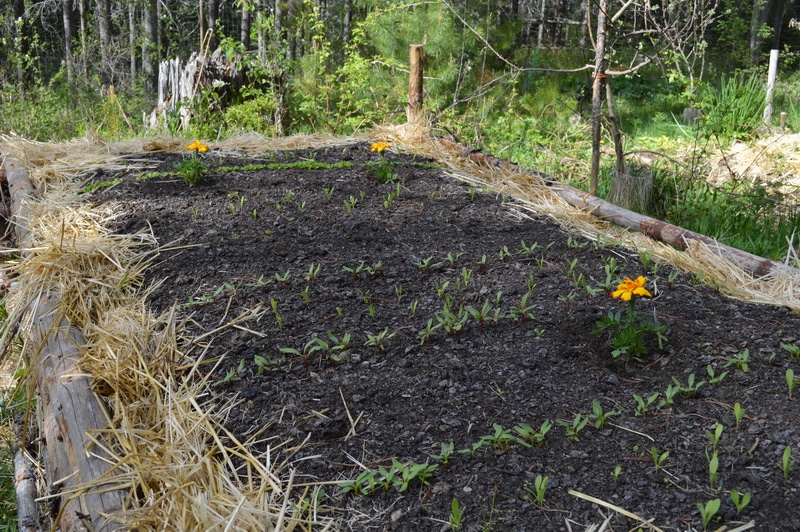
If you have a source of manure and waste wood, give hugelkultur beds a trial run on your homestead. But don’t settle for the low beds. Instead build up the bio-mass and extend the height and make a hugelkultur bed that will be kind to you in your senior years.



I really enjoyed your article! I very much appreciate you sharing issues and concerns youve had as well as the successes
Reading possible solutions to problems or work-arounds is so helpful and a timesaver. As an inexperienced gardener, learning by trial and error, sometimes even Professor Google can’t help me identify what’s wrong, or what to expect , espexially when i dont even know what to ask 🙂
Thank you for sharing your experiences.
Paula
cedar bark mulch around the base of my cherry tree does a great job of stopping ants from getting to the fruit and works well around the base of my house so it should work well if you put it in or around your garden? also mint will keep the majority of critters/rodents away from, well, anywhere you don’t want them,, maybe incorporate chopped plants in the layers and/or plant in beds with problems? yes it’s a weed but on par with dandelion as to health benefits!
Yes, baling twine. He put the corner posts into the ground and then tied each level of support log in place as he was filling it. The inside is logs and waste wood, plus hay, manure, leaves, branches, and what ever organic waste we could find. Topped up with finished compost so it could be planted right away. One thing though, if you have poisonous snakes it isn’t a good idea. I did see garter snakes making their home in the bed.
Great post! How did he construct those beds – is that baling twine he used to lash them together?
I’d love to see pictures when you are done. I hope it gives you the adjustment that you need to be able to fully enjoy your garden time.